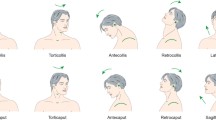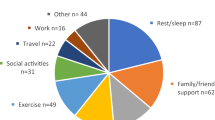Abstract
Sensory trick is an unusual clinical feature in cervical dystonia that attenuates disease symptoms by slight touch to a specific area of the face or head. Using a semi-quantitative questionnaire-based study of 197 patients with idiopathic cervical dystonia, we sought to determine probable pathophysiologic correlates, with the wider aim of examining its eventual clinical significance. The typical sensory trick, i.e., light touch, not necessitating the use of force leading to simple overpowering of dystonic activity, was present in 83 (42.1 %) patients. The vast majority of the patients required a specific sequence of sensorimotor inputs, including touch sensation on the face or different areas of the head, and also sensory and motor input of the hand itself. Deviations often led to a significant decrease in effectiveness and lack of expected benefit. Moreover, patients able to perform the maneuver reported compellingly higher subjective effect of botulinum toxin treatment (median 7 vs. 5 on a scale of 0–10; p < 0.0001) and lower depression score (median 10 vs. 14 on the Montgomery Åsberg Depression Rating scale; p < 0.001). Overall, the results point to marked disruption of sensorimotor networks in cervical dystonia. The mechanism of the sensory trick action may be associated with balancing the abnormal activation patterns by specific sensorimotor inputs. Its presence may be considered a positive predictive factor for responsiveness to botulinum toxin treatment.




Similar content being viewed by others
References
Abbruzzese G, Berardelli A (2011) Further progress in understanding the pathophysiology of primary dystonia. Mov Disord 26(7):1185–1186. doi:10.1002/mds.23707
Albanese A, Asmus F, Bhatia KP, Elia AE, Elibol B, Filippini G, Gasser T, Krauss JK, Nardocci N, Newton A (2011) EFNS guidelines on diagnosis and treatment of primary dystonias. Eur J Neurol 18(1):5–18. doi:10.1111/j.1468-1331.2010.03042.x
Cano SJ, Warner TT, Linacre JM, Bhatia KP, Thompson AJ, Fitzpatrick R, Hobart JC (2004) Capturing the true burden of dystonia on patients The Cervical Dystonia Impact Profile (CDIP-58). Neurology 63(9):1629–1633. doi:10.1212/01.WNL.0000142962.11881.26
Currà A, Trompetto C, Abbruzzese G, Berardelli A (2004) Central effects of botulinum toxin type A: evidence and supposition. Mov Disord 19(S8):S60–S64. doi:10.1002/mds.20011
Fahn S (1984) The varied clinical expressions of dystonia. Neurol Clin 2:541–554. doi:10.1016/j.jneumeth.2014.05.027
Fahn S (1988) Concept and classification of dystonia, vol 50. Raven Press, New York
Fahn S, Bressman SB, Marsden CD (1998) Classification of dystonia. Adv Neurol 78:1–10
Filip P, Lungu OV, Bareš M (2013a) Dystonia and the cerebellum: a new field of interest in movement disorders? Clin Neurophysiol 124:1269–1276. doi:10.1016/j.clinph.2013.01.003
Filip P, Lungu OV, Shaw DJ, Kasparek T, Bareš M (2013b) The mechanisms of movement control and time estimation in cervical dystonia patients. Neural Plast 2013:908741. doi:10.1155/2013/908741
Gómez-Wong E, Marti MJ, Cossu G, Fabregat N, Tolosa ES, Valls-Solé J (1998) The geste antagonistique induces transient modulation of the blink reflex in human patients with blepharospasm. Neurosci Lett 251(2):125–128. doi:10.1016/S0304-3940(98)00519-9
Greene PE, Bressman S (1998) Exteroceptive and interoceptive stimuli in dystonia. Mov Disord 13(3):549–551. doi:10.1002/mds.870130329
Hanakawa T, Dimyan MA, Hallett M (2008) Motor planning, imagery, and execution in the distributed motor network: a time-course study with functional MRI. Cereb Cortex 18(12):2775–2788. doi:10.1093/cercor/bhn036
Inoue K, Hashimoto I, Shirai T, Kawakami H, Miyachi T, Mimori Y, Matsumoto M (2004) Disinhibition of the somatosensory cortex in cervical dystonia-decreased amplitudes of high-frequency oscillations. Clin Neurophysiol 115(7):1624–1630. doi:10.1016/j.clinph.2004.02.006
Jahanshahi M (2000) Factors that ameliorate or aggravate spasmodic torticollis. J Neurol Neurosurg Psychiatry 68(2):227–229. doi:10.1136/jnnp.68.2.227
Jost Wolfgang H, Hefter Harald, Stenner Andrea, Reichel Gerhard (2013) Rating scales for cervical dystonia: a critical evaluation of tools for outcome assessment of botulinum toxin therapy. J Neural Transm 120(3):487–496. doi:10.1007/s00702-012-0887-7
Kaji R, Rothwell JC, Katayama M, Ikeda T, Kubori T, Kohara N, Mezaki T, Shibasaki H, Kimura J (1995) Tonic vibration reflex and muscle afferent block in writer’s cramp. Ann Neurol 38(2):155–162. doi:10.1002/ana.410380206
Kanovsky P, Bares M, Streitova H, Klajblova H, Daniel P, Rektor I (2003) Abnormalities of cortical excitability and cortical inhibition in cervical dystonia—evidence from somatosensory evoked potentials and paired transcranial magnetic stimulation recordings. J Neurol 250(1):42–50. doi:10.1007/s00415-003-0942-2
Marsden CD, Obeso JA, Zarranz JJ, Lang AE (1985) The anatomical basis of symptomatic hemidystonia. Brain 108(2):463. doi:10.1093/brain/108.2.463
Martino D, Liuzzi D, Macerollo A, Aniello MS, Livrea P, Defazio G (2010) The phenomenology of the geste antagoniste in primary blepharospasm and cervical dystonia. Mov Disord 25(4):407–412. doi:10.1002/mds.23011
Molho ES, Factor SA, Podskalny GD, Brown D (1996) The effect of dancing on dystonia. Mov Disord 11(2):225–227. doi:10.1002/mds.870110220
Montgomery SA, Asberg M (1979) A new depression scale designed to be sensitive to change. Br J Psychiatry 134(4):382–389. doi:10.1192/bjp.bp.106.032532
Müller J, Wissel J, Masuhr F, Ebersbach G, Wenning GK, Poewe W (2001) Clinical characteristics of the geste antagoniste in cervical dystonia. J Neurol 248(6):478–482. doi:10.1002/mds.870130329
Munhoz RP, Lang AE (2004) Gestes antagonistes in psychogenic dystonia. Mov Disord 19(3):331–332. doi:10.1002/mds.10628
Naumann M, Magyar-Lehmann S, Reiners K, Erbguth F, Leenders KL (2000) Sensory tricks in cervical dystonia: perceptual dysbalance of parietal cortex modulates frontal motor programming. Ann Neurol 47(3):322–328. doi:10.1002/mds.25305
Ochudło S, Drzyzga K, Drzyzga ŁR, Opala G (2007) Various patterns of gestes antagonistes in cervical dystonia. Parkinsonism Relat Disord 13(7):417–420. doi:10.1016/j.parkreldis.2007.01.004
Opavský R, Hluštík P, Otruba P, Kaňovský P (2011) Sensorimotor network in cervical dystonia and the effect of botulinum toxin treatment: a functional MRI study. Neurol Sci 306(1):71–75. doi:10.1016/j.jns.2011.03.040
Patel N, Hanfelt J, Marsh L, Jankovic J (2014a) Alleviating manoeuvres (sensory tricks) in cervical dystonia. J Neurol Neurosurg Psychiatry 85:882–884. doi:10.1136/jnnp-2013-307316
Patel N, Jankovic J, Hallett M (2014b) Sensory aspects of movement disorders. Lancet Neurol 13(1):100–112. doi:10.1016/S1474-4422(13)70213-8
Poisson A, Krack P, Thobois S, Loiraud C, Serra G, Vial C, Broussolle E (2012) History of the ‘geste antagoniste’ sign in cervical dystonia. J Neurol 259(8):1580–1584. doi:10.1007/s00415-011-6380-7
Putzki N, Stude P, Konczak J, Graf K, Diener HC, Maschke M (2006) Kinesthesia is impaired in focal dystonia. Mov Disord 21(6):754–760. doi:10.1002/mds.20799
Ramirez-Castaneda J, Jankovic J (2013) Long-term efficacy and safety of botulinum toxin injections in dystonia. Toxins 5(2):249–266. doi:10.3390/toxins5020249
Ramos VFML, Karp BI, Hallett M (2014) Tricks in dystonia: ordering the complexity. J Neurol Neurosurg Psychiatry 85:987–993. doi:10.1136/jnnp-2013-306971
Schramm A, Reiners K, Naumann M (2004) Complex mechanisms of sensory tricks in cervical dystonia. Mov Disord 19(4):452–458. doi:10.1002/mds.10689
Tan EK, Chan LL (2005) Sensory tricks and treatment in primary lingual dystonia. Mov Disord 20(3):388. doi:10.1002/mds.20388
Tang JKH, Mahant N, Cunic D, Chen R, Moro E, Lang AE, Lozano AM, Hutchison WD, Dostrovsky JO (2007) Changes in cortical and pallidal oscillatory activity during the execution of a sensory trick in patients with cervical dystonia. Exp Neurol 204(2):845–848. doi:10.1016/j.expneurol.2007.01.010
Tinazzi M, Fiorio M, Fiaschi A, Rothwell JC, Bhatia KP (2009) Sensory functions in dystonia: insights from behavioral studies. Mov Disord 24(10):1427–1436. doi:10.1002/mds.22490
Vidailhet M, Grabli D, Roze E (2009) Pathophysiology of dystonia. Curr Opin Neurol 22(4):406–413. doi:10.1097/WCO.0b013e32832d9ef3
Wiener WJ, Nora LM (1984) “Trick” movements in facial dystonia. J Clin Psychiatry 45:519–521. doi:10.1111/j.1600-0447.1986.tb02735.x
Wissel J, Müller J, Ebersbach G, Poewe W (1999) Trick maneuvers in cervical dystonia: investigation of movement-and touch-related changes in polymyographic activity. Mov Disord 14(6):994–999. doi:10.1136/jnnp-2013-307316
Wissel J, Kanovsky P, Ruzicka E, Bares M, Hortova H, Streitova H, Jech R, Roth J, Brenneis C, Muller J, Schnider P, Auff E, Richardson A, Poewe W (2001) Efficacy and safety of a standardised 500 unit dose of Dysport (R) (Clostridium botulinum toxin type A haemaglutinin complex) in a heterogeneous cervical dystonia population: results of a prospective, multicentre, randomised, double-blind, place bo-controlled, parallel group study. J Neurol 248(12):1073–1078. doi:10.1007/s004150170028
Acknowledgments
The authors are grateful to the patients and their families for their support of this research. This work was supported by Ministry of Health of the Czech Republic/Ministry of Health’s Departmental Research and Development Program III (2010–2015) NT/13437 and by the “CEITEC—Central European Institute of Technology” Project (CZ.1.05/1.1.00/02.0068) from the European Regional Development Fund.
Author information
Authors and Affiliations
Corresponding author
Ethics declarations
Conflict of interest
There are no potential conflict of interests regarding this paper and no financial or personal relationships that might bias this work.
Rights and permissions
About this article
Cite this article
Filip, P., Šumec, R., Baláž, M. et al. The clinical phenomenology and associations of trick maneuvers in cervical dystonia. J Neural Transm 123, 269–275 (2016). https://doi.org/10.1007/s00702-015-1488-z
Received:
Accepted:
Published:
Issue Date:
DOI: https://doi.org/10.1007/s00702-015-1488-z




